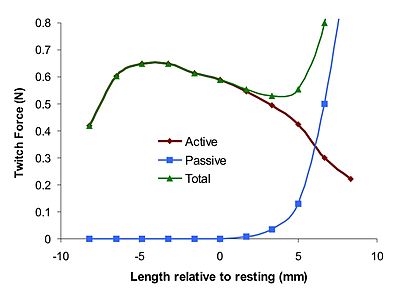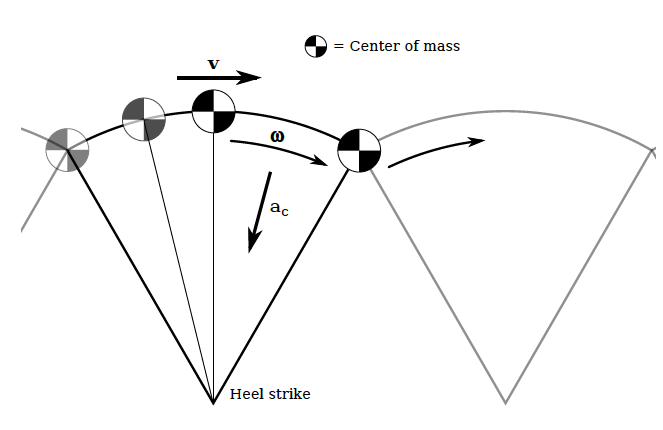class: center, middle, inverse, title-slide .title[ # Lecture 2 ] .subtitle[ ## Terrestrial Locomotion I ] .author[ ### Dr. Christopher Kenaley ] .institute[ ### Boston College ] .date[ ### 2025/1/16 ] --- class: inverse, top # Terrestrial locomotion ``` ## Warning: package 'ggplot2' was built under R version 4.2.3 ``` ``` ## Warning: package 'kableExtra' was built under R version 4.2.3 ``` <!-- Add icon library --> <link rel="stylesheet" href="https://cdnjs.cloudflare.com/ajax/libs/font-awesome/5.14.0/css/all.min.css"> .pull-left[ Today we'll .... - Consider how we characterize terrestrial walking with legs - Focus on bipedal locomotion - Apply the inverted pendulum model to bipedalism - Discuss the predictions of the model - Take a peak at AME1 and MP1 ] .pull-right[  ] --- class: top # But first, some ground rules and metrics .pull-left[ ## Important definitions - **Kinematics:** Position over space and time (2D or 3D). - **Kinetics:** Forces moving masses. - **Dynamics:** Changes in properties like forces, mass, energy, etc. over space and time (i.e. stability). - **Power:** How quickly work is done (i.e., energetics). ] .pull-right[ ## Some examples .center[ <video width="500" controls> <source src="img/eel.mp4" type="video/mp4"> </video> ] ] --- class: top # Some ground rules and metrics .pull-left[ ## Important definitions - **Kinematics:** Position over space and time (2D or 3D). - **Kinetics:** Forces moving masses. - **Dynamics:** Changes in properties like forces, mass, energy, etc. over space and time (i.e. stability). - **Power:** How quickly work is done (i.e., energetics). ] .pull-right[ ## Some examples .center[  ] ] --- class: top # Some ground rules and metrics .pull-left[ ## Important definitions - **Kinematics:** Position over space and time (2D or 3D). - **Kinetics:** Forces moving masses. - **Dynamics:** Changes in properties like forces, mass, energy, etc. over space and time (i.e. stability). - **Power:** How quickly work is done (i.e., energetics). ] .pull-right[ ## Some examples .center[  ] ] --- class: top # Some ground rules and metrics .pull-left[ ## Important definitions - **Kinematics:** Position over space and time (2D or 3D). - **Kinetics:** Forces moving masses. - **Dynamics:** Changes in properties like forces, mass, energy, etc. over space and time (i.e. stability). - **Power:** How quickly work is done (i.e., energetics). ] .pull-right[ ## Some examples .center[  ] ] $$\textrm{Watt}= \textrm{kg}\cdot \textrm{m}^2\cdot \textrm{s}^{-3} $$ `$$1 \textrm{Watt} \approx \textrm{10.5 mL O}_2 \textrm{ min}^{-1}$$` --- class: top # Some ground rules and metrics .pull-left[ - **Stride length:** Distance between consecutive footfalls of the same foot (in m) - **Stride frequency:** number of strides per time (if s, in Hz) - **Duty factor:** fraction of stride time that a foot is on the ground (non-dimensional) + e.g.,human walking = 0.5 - 0.6, running = 0.35). + Gaits with duty factors less than 0.5 imply airborne phases, i.e., running - **Relative Phase:** Point in time a foot touches as a fraction of the stride time (non dimensional or in `\(^o\)`, often). ] .pull-right[ <img src="https://encrypted-tbn0.gstatic.com/images?q=tbn:ANd9GcRk6lEBWg4QHMBQqBjpOaMKXk5oRgxIjo5JkQ&usqp=CAU" width="250" /><img src="https://www.researchgate.net/profile/Thomas_Moeslund/publication/221908232/figure/fig2/AS:305169892954113@1449769580296/Illustration-of-the-duty-factor-The-duration-of-a-gait-cycle-where-each-foot-is-on-the.png" width="250" /> ] --- class: top <!-- slide 1 --> # Up first: Walking ## First, a question Say you're on Mars. Do you walk faster or slower than you do on Earth? .pull-left[  ] .pull-right[ 1/3 the gravity as Earth ] --- class: top <!-- slide 1 --> # Up first: Walking ## Modeling walking as an inverted pendulum .pull-left[  .center[ <img src="img/centrip.png" width="150" /> ] ] .pull-right[  ] --- class: top # What are the predictions of such a model? .pull-left[  .center[ <img src="img/centrip.png" width="150" /> ] ] .pull-right[ - Velocity? - Kinetic energy? - COM oscillations (kinetics, kinematics)? ] --- class: top <!-- slide 1 --> # What are the predictions of such a model? .pull-left[  .center[ <img src="img/centrip.png" width="150" /> `$$F_c=ma_c=\frac{mv^2}{r}$$` ] ] .pull-right[ Acceleration toward the pivot (center) can be expressed as `$$a_c=\frac{v^2}{r}$$` [why?] Which means that `\(v^2=a_cr\)`, or, if `\(L=r\)` `$$v^2 \leq gL$$` [why?] ] --- class: top <!-- slide 1 --> # Back to the questions Say you're on Mars. Do you walk faster or slower than you do on Earth? .pull-left[   ] .pull-right[ .center[ If `$$v^2 \leq gL$$` then `$$v\leq \sqrt{gL}$$` ] ] --- class: # How well does the model do? Or, How well do our iverted pendula do? `$$Fr =\frac{centripetal force}{gravitational force}=\frac{\frac{mv^2}{L}}{mg}=\frac{v^{2}}{gL}$$` or `$$Fr=\frac{realized force}{predicted force}$$` .center[ <img src="img/froudegait.jpg" width="550" /> ] --- class: top <!-- slide 1 --> # What can change speed under this model? .pull-left[ .center[L, right?] - Lumbar flexion - Pelvic rotation - Pelvic tilt (in transverse, frontal planes) - Plantar flexion More on this later . . . <img src="img/pelvicwalk.png" width="200" /> ] .pull.right[ <img src="img/pelvictilt.jpg" width="300" /> <img src="https://anatomypubs.onlinelibrary.wiley.com/cms/asset/9d091d74-842a-46b7-b722-8010fe918ebb/ar23552-fig-0002-m.jpg" width="200" /> ] --- # For AME1 and MP1 .pull-left[ <img src="rlogo.png" width="100" />  ] .pull-right[  IDE: Integrated Development Environment ] - Download R first - Download R Studio second --- class: center, middle # Thanks! Slides created via the R package [**xaringan**](https://github.com/yihui/xaringan).